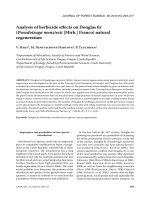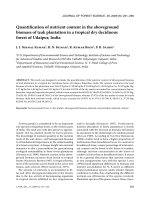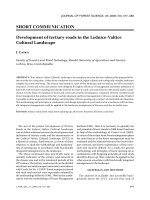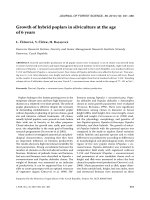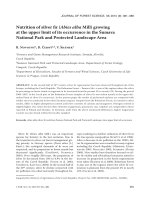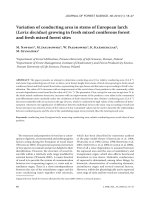Báo cáo lâm nghiệp: "Nutrition of silver fir (Abies alba Mill) growing at the upper limit of its occurrence in the Šumava National Park and Protected Landscape Area" pot
Bạn đang xem bản rút gọn của tài liệu. Xem và tải ngay bản đầy đủ của tài liệu tại đây (921 KB, 8 trang )
J. FOR. SCI., 56, 2010 (9): 381–388 381
JOURNAL OF FOREST SCIENCE, 56, 2010 (9): 381–388
Nutrition of silver fir (Abies alba Mill) growing
at the upper limit of its occurrence in the Šumava
National Park and Protected Landscape Area
R. N
1
, D. Č
2,3
, V. Š
1
1
Forestry and Game Management Research Institute, Strnady, Jíloviště,
Czech Republic
2
Šumava National Park and Protected Landscape Area, Department of Forest Ecology,
Vimperk, Czech Republic
3
Department of Silviculture, Faculty of Forestry and Wood Sciences, Czech University of Life
Sciences in Prague, Czech Republic
ABSTRACT: In the second half of 20
th
century silver fir regeneration has been observed throughout all of the
Europe, including the Czech Republic. The Bohemian Forest – Šumava Mts. is one of the regions where the silver
fir percentage in forest stands is supposed to be increased from the present 2% to nearly 12%. During the period
2006–2007, in the Czech part of the Bohemian Forest, samples of silver fir were taken mainly in the upper alti-
tudinal limit of silver fir occurrence. In the present paper the results of performed analyses are compared with
similar surveys conducted in the other European regions. Samples from the Bohemian Forest, in contrast to other
results, differ in higher phosphorus content and lower contents of calcium and manganese. Nitrogen content is
slightly higher. Our values for the other elements (magnesium, potassium, zinc, sulphur) are comparable to those
reported in Poland and Slovakia. In Germany, aside from the above mentioned differences, higher magnesium
content was also found within the locality sampled.
Keywords: Abies alba; silver fir nutrition; Šumava National Park and Protected Landscape Area; upper limit of occurrence
Supported by Ministry of Agriculture of the Czech Republic, Projects No. MZE 0002070203 and No. 1G58031.
Silver fir (Abies alba Mill.) was an important
species for forestry in the last centuries. Due to
the transition to clear-cut forest management giv-
ing priority to Norway spruce (Picea abies [L.]
Karst.), the ecological demands of fir were not
respected, and its proportion in forest stands has
decreased significantly (U, K
2004). Over roughly 200 years, the proportion of
silver fir decreased from 18% to 0.9% in the for-
ests of the Czech Republic (V et al. 2002;
U, K 2004). In the second half of
the 20
th
century, silver fir decline connected with
air pollution was observed nearly throughout Eu-
rope resulting in a further reduction of silver fir in
the tree species composition (S et al. 1984).
After a decrease in air pollution in the 1990’s, Sil-
ver fir regeneration was recorded in many regions
including the Czech Republic (H, E-
2001; P 2002; S, M
2004). New studies have therefore focused on sil-
ver fir vitality and silvicultural measures aimed to
increase its proportion in the forest regeneration
were taken (Š et al. 2008). Bohemian Forest
is also one of the regions where the silver fir res-
toration is planned, from the present 2% to nearly
12% (V et al. 2002).
382 J. FOR. SCI., 56, 2010 (9): 381–388
e natural range of silver fir is discontinuous. It
grows in the mountains of Southern Europe, from
the Pyrenees to the Balkans. e main centres of
the range are situated in Central France, Western
Germany, and the mountainous regions of South-
ern Europe (M 1999; U, K
2004). In Central Europe, it grows up to 1,000 m
a.s.l., in the Bohemian Forest up to 1,300 m a.s.l.
(the highest fir was discovered at 1,338 m a.s.l.
– “the fir of Skala” in Jezerní hora, personal noti-
fication), in the Alps up to 1,700 m a.s.l. Fir grows
most frequently in a mixture with Norway spruce
or European beech, or together with these two
species.
e fir has relatively great requirements for soil
conditions – it needs deep, aerated and humid soils
as well as high air humidity. It roots deeper than
all other conifer species, and it is also less affected
by windthrows. e fir demand for oxygen content
in the soil is relatively low – it can grow in deeper
and wetter soils than e.g. Norway spruce. It is a
typical shade-tolerant species; in the open area, it
suffers from frost and bark scorch (M 1999;
www.weisstanne.de).
Nutrient content in silver fir needles has been
studied in less detail than in other commercially
more important species. In the Carpathian region,
some studies were performed e.g. by M
(1996); M et al. (2004); problems of bio-
diversity and its changes were studied by Š
and V (2007). In Croatia, the content of
some elements in the fir needles was analyzed by
P et al. (2005), in Germany by M et
al. (2004), B et al. (1995), and in France by
P et al. (2008).
e paper presents the results of the nutrient bal-
ance and content of the stress elements in the cur-
rent year needles of fir taken in 2006 and 2007 in
the Bohemian Forest, in the mature stands growing
predominantly above 1,100 m a.s.l.
MATERIAL AND METHODS
Samples of silver fir needles were taken in the
Bohemian Forest during the winter 2006–2007.
Sampling was focused on the upper limit of silver
fir growth, namely from 1,110 to 1,300 m a.s.l. In
the western part of the Bohemian Forest samples
were taken at altitudes exceeding 1,100 m a.s.l. In
the southern part, sampling was done at altitudes
above 1,200 m a.s.l. Forest stands of the 7
th
(spruce-
beech) and 8
th
(spruce) altitudinal vegetation zone
were a criterion for sampling. For a comparison,
the samples of the 6
th
altitudinal vegetation zone
(beech-spruce) were also taken (the altitude of
800–900 m a.s.l.). A total of 81 samples were taken;
20 samples in the 6
th
altitudinal vegetation zone
– localities Včelná, Rejštejn, Nová Pec, 36 samples
in the 7
th
altitudinal vegetation zone – localities
Zhůří, Modrava, Antýgl, Pod Plesnou, 25 samples
in the 8
th
altitudinal vegetation zone – localities
Plechý – Stifterův památník, Jezerní hora, Bučina,
Weitfelerské slatě, Jelení skok. e current year
needles were prepared for analyses. A map of sam-
pling localities is shown in Fig. 1.
Samples were taken during the dormancy period
(January–March) from dominant and co-dominant
trees and from the 2
nd
or 3
rd
whorl. All sampled
trees were fructiferous. Samples of the current year
needles were analyzed in a laboratory of the Forest
and Game Management Research Institute, using
the ICP Forests (UN-ECE 2005) methodology and
the Standard Operation Procedures. Contents of
nitrogen, potassium, phosphorus, magnesium, cal-
cium, zinc, iron, manganese and sulphur were ana-
lyzed in all samples by the OES-ICP method after
nitric acid and hydrogen peroxide decomposition
of the plant material in an MDS-2000 microwave
system. Total nitrogen and sulphur were deter-
mined with a CNS analyzer. Chlorine was deter-
mined using argentometric titration in the plant
material following decomposition with sodium
carbonate. Fluoride content was analyzed by the
ion-selective method after alkaline decomposition
of ash. Statistical evaluation was done using the
Statistica Cz software.
Fig. 1. Map of sampling sites
J. FOR. SCI., 56, 2010 (9): 381–388 383
RESULTS AND DISCUSSION
e basic results of the chemical analyses are pre-
sented in Table 1. e median is used as a more
robust parameter than the arithmetic mean.
e element content in the needles was formerly
analyzed and evaluated e.g. by M et al.
(2004) or B et al. (1995). Our results from
the Bohemian Forest are comparable with their re-
sults and conclusions.
Nitrogen content ranges from 9.5 to 21.5 g·kg
–1
,
the median is 13.5 g·kg
–1
. e above-mentioned
publications reported a mean value from 11.0 to
12.5 g· kg
–1
for the localities in Germany, Poland,
and Slovakia. It should be noted that the cited pub-
lications used the arithmetic mean, not the median.
e mean nitrogen content in our samples was even
higher – 13.9 g·kg
–1
.
For conifers, the deficiency limit of 13 g·kg
–1
is generally used. About one quarter of the ana-
lyzed samples fall below this level (lower quartile
12.6 g·kg
–1
).
Phosphorus content in the samples ranges from
997 to 4,099 mg·kg
–1
, the arithmetic mean is
2,078 mg
·kg
–1
and the median 1,952 mg·kg
–1
. e
average values in Germany, Poland, and Slovakia
were significantly lower – around 1,400 mg·kg
–1
.
Magnesium content in the samples from the Bo-
hemian Forest ranges from 493 to 3,554 mg·kg
–1
,
the arithmetic mean is 1,971 mg·kg
–1
, the median
is 1,953 mg·kg
–1
. In the locality in Germany (Ba-
varian Alps), the average value of 2,400 mg·kg
–1
was measured. In Poland and Slovakia, the aver-
age content of magnesium in the fir needles was
around 1,500 mg
·kg
–1
. e problem of magnesium
in forest ecosystems was studied e.g. by H
(1986) and H and S (1997). eir de-
termined threshold for magnesium deficiency
was 700–800 mg
·kg
–1
. Magnesium content below
800 mg·kg
–1
was determined only in three of the
analyzed samples. In this respect, the nutrition of
the youngest needles is satisfactory. e measured
mean value is higher compared to the data present-
ed in M et al. (2004).
Calcium content in the needles is more sta-
ble; its content increases with the age of needles.
In the current year needles, the discovered val-
ues range from 810 to 10,935 mg·kg
–1
. e me-
dian is 5,115 mg
·kg
–1
, the mean is 5,432 mg·kg
–1
.
In the study by B et al. (1995), the mean
10,900 mg
·kg
– 1
in the current year needles of fir was
found; in the samples from Slovakia and Poland, the
values ranged from 10,400 to 15,500 mg·kg
–1
.
e regulation of water regime is one of the most
important functions of potassium, and this is also
important in the resistance of individual tree spe-
cies to different stresses (e.g. resistance to frost).
Its content in the analyzed samples from the Bohe-
mian Forest ranges from 3,352 to 11,067 mg·kg
–1
.
e arithmetic mean is 6,198 mg·kg
–1
, the median is
5,862 mg·kg
–1
. H (1986) reported a deficiency
limit value of 4,000–4,500 mg·kg
–1
. A portion of the
samples had a lower potassium content compared to
this value. In other sources, the mean potassium con-
tent varies from 6,453 (Slovakia) to 8,112 (Poland)
mg·kg
–1
(M et al. 2004). In Germany, the
mean value in the tested samples was 7,700 mg·kg
–1
(B et al. 1995; M et al. 2004).
Table 1. Results of basic data analysis
Valid N Mean Median Minimum Maximum
Lower
quartile
Upper
quartile
Range SD
Ca (mg·kg
–1
) 81 5,431.569 5,115.211 810.824 10,935.19 3,837.053 6,861.417 5,122,780 2,263.356
Fe (mg·kg
–1
) 81 53.925 50.561 31.805 157.00 43.751 56.826 369 19.209
K (mg·kg
–1
) 81 6,197.953 5,862.083 3,352.310 11,066.98 4,827.199 7,345.797 2,605,996 1,614.310
Mg (mg·kg
–1
) 81 1,971.348 1,953.478 493.425 3,554.40 1,537.206 2,445.327 404,383 635.911
Mn (mg·kg
–1
) 81 624.807 503.981 145.070 2,198.78 354.223 732.385 193,874 440.312
P (mg·kg
–1
) 81 2,077.645 1,952.093 997.176 4,098.89 1,536.828 2,398.292 476,576 690.345
Zn (mg·kg
–1
) 81 41.027 39.503 12.037 72.52 33.288 50.179 153 12.375
N (%) 81 1.389 1.353 0.945 2.15 1.259 1.512 0 0.188
S (mg·kg
–1
) 81 1,347.654 1,323.950 1,050.000 1,795.00 1,196.630 1,445.920 38,522 196.269
Cl (mg·kg
–1
) 69 373.853 352.877 146.520 759.03 275.237 451.387 20,020 141.494
F (mg·kg
–1
) 69
1.736 1.649 0.100 6.35 1.462 1.847 1 0.857
SD – Standard deviation
384 J. FOR. SCI., 56, 2010 (9): 381–388
As an important trace element, the zinc content
was analyzed. It ranged from 12 to 73 mg·kg
–1
,
with the mean value 41 mg·kg
–1
and the median
39.5 mg
·kg
–1
. Zinc plays an important role in the
formation of chlorophyll and it takes part in many
metabolic processes. Its content generally cor-
relates with that of magnesium. e zinc content
was also analyzed in the papers by B et al.
(1995) and M et al. (2004). e mean
value measured in the sampled locality in Germa-
ny was 63 mg·kg
–1
; for the localities in Poland and
Slovakia it was 30 and 39 mg·kg
–1
, respectively. e
average value measured in the Bohemian Forest
was comparable with the localities in Poland and
Slovakia.
e sulphur values range from 1,050 to
1,795 mg
·kg
–1
. e mean is 1,348 mg·kg
–1
, the me-
dian 1,324 mg·kg
–1
. In the study by M
et al. (2004) the average sulphur concentrations
determined in silver fir needles presented were
roughly 1,350 mg.kg
–1
, i.e. comparable with those
presented here. B et al. (1995) reported the
higher mean value – 1,600 mg·kg
–1
.
e iron content ranges from 32 to 157 mg·kg
– 1
.
e mean value is 53.3 mg·kg
–1
; the median is
50 mg.kg
–1
. In the samples from Poland, the value
92 mg.kg
–1
was found; in the samples from Slovakia,
it was 215 mg·kg
–1
(M et al. 2004). In the
samples from Germany, the mean was 71 mg·kg
–1
(B et al. 1995).
Fig. 2. Box plots of nutrient contents
J. FOR. SCI., 56, 2010 (9): 381–388 385
Fig. 3. Categorized histograms – nitrogen (%), magnesium (mg·kg
–1
) and calcium (mg·kg
–1
)
386 J. FOR. SCI., 56, 2010 (9): 381–388
Manganese content was 145–1,246 mg.kg
–1
; the
arithmetic mean was 507, the median 458 mg·kg
– 1
.
B et al. (1995) reported the value 531 mg·kg
–1
in the current year needles, M et al.
(2004) presented the mean of 1,623 mg·kg
–1
for the
samples from the localities in Poland, and the mean
of 1,174 mg·kg
–1
for the samples taken in Slovakia.
e values discovered in the Bohemian Forest are
significantly lower, compared to those mentioned
above.
In a number of the samples (55 of 67), the con-
tent of other stress elements was also analyzed
– i.e. fluorine and chlorine. e content of fluorine
ranged from 0.1 to 6.4 mg·kg
–1
, with the average
1.75 mg·kg
–1
and median 1.63 mg·kg
–1
.
e chlorine content ranged from 147 mg·kg
–1
to
759 mg·kg
–1
, with the average 374 mg·kg
–1
and me-
dian 353 mg·kg
–1
.
e basic nutrient contents are represented
graphically in Fig. 2.
e relationship between the element content
and the altitude was tested; results are presented in
Table 2. Within the data set evaluated, sulphur con-
tent in silver fir needles increases significantly and
calcium content decreases significantly with alti-
tude. Along with a moderate decrease in magne-
Fig. 4. Categorized histograms – sulphur and chlorine (mg·kg
–1
)
J. FOR. SCI., 56, 2010 (9): 381–388 387
sium content and an insignificant increase in nitro-
gen content, this may be due to higher acidification
of soils at higher altitudes. However, the significant
increase in potassium content with altitude does
not support this hypothesis. It is possible that the
grass layer could be a source of higher potassium
content. In less dense forest stands of higher alti-
tudes, the grass litter is richer in potassium (com-
parably similar trends see e.g. P 2007).
e fact that the samples were taken approxi-
mately at two levels of altitude must be considered.
One, a smaller group, was taken at an altitude of
about 800–900 m a.s.l.; the other was taken be-
tween 1,100 and 1,300 m a.s.l.
Element contents in needles were also evaluated
by means of categorized histograms. e forest
type group (FTG) was a criterion. Most samples
were taken in the forest type groups 7K (acid soils
in the 7
th
altitudinal vegetation zone) and 8K (acid
soils in the 8
th
altitudinal vegetation zone). Fig. 3
and Fig. 4 show histograms for selected elements.
In the higher altitudinal zone of silver fir occur-
rence in the Bohemian Forest, i.e. at the altitude
above 1,000 (1,100) m a.s.l., no significant differ-
ences in the content of the evaluated elements were
recorded in connection with the forest type group
– FTG. Chloride content, higher in FTG 8K than in
other FTGs, is the only exception.
When comparing all the samples, the histograms
show differences in the content of sulphur between
the 6
th
altitudinal vegetation zone on the one hand
and the 7
th
and 8
th
altitudinal vegetation zone on the
other. Even the Bohemian Forest, although generally
considered less afflicted by air pollution, has been
exposed to emissions to a certain extent; this, in
spite of the fact that this load is currently in the form
of deposits and not in the form of a high concentra-
tion load of harmful gases in the ambient air.
is correlation trend with respect to the for-
est type groups (FTG) was not recorded for other
elements.
CONCLUSIONS
Silver fir, growing in the Bohemian Forest at higher
elevations (1,110–1,300 m a.s.l.), shows a good nutri-
ent supply. In spite of this, individual trees or localities
can be identified in which a lower content of certain
elements, mainly magnesium, under the deficiency
limit has been recorded. In general, the situation
based on the current year needle analysis is good.
Compared to other studies, results differ main-
ly in higher phosphorus content, and lower cal-
cium and manganese contents. Nitrogen content
is slightly higher. For other elements (magnesium,
potassium, sulphur), the values are comparable
with those from Poland and Slovakia. In the local-
ity sampled in Germany, a higher content of mag-
nesium (aside from the above mentioned) was also
discovered. e comparison of sulphur content has
to be considered carefully since, compared to the
study by B et al. (1995), the air pollution
situation has changed, and thus the sulphur con-
tent cannot be compared equally.
When evaluating the correlation of the element
content with the altitude, the positive correlation
for sulphur and potassium was significant, in ad-
dition to the negative correlation for calcium and
manganese.
Comparing differences in individual forest type
groups (FTG), in which the tested fir trees grow,
differences in nutrient contents were discovered
especially in FTG 6B. In this rich, spruce-beech for-
est site type in the 6
th
altitudinal vegetation zone,
higher contents of magnesium, calcium, and zinc
in needles were determined. e decline or dieback
of fir in this region, when recorded, must be con-
sidered individually, keeping in mind other stress
factors (biotic agents, meteorological conditions).
Re feren ces
B R., G T., Z W. (1995): Nährele-
ment- und Schwermetallgehalte in den Nadeln von
Fichten und Tannen eines Bergmimschwaldes auf Flysch
(Tegernseer Alpen). Forstwiesenschaftliches Centralblatt,
114: 30–39.
Table 2. Correlations between the altitude and nutrient
content (marked correlations are significant at a level
P < 0.05) (N = 69)
Altitude
Ca –0.4755
Fe –0.0981
K 0.3441
Mg –0.1687
Mn –0.5882
P 0.1501
Zn –0.0560
N 0.2049
S 0.3648
Cl 0.0484
F –0.0058
388 J. FOR. SCI., 56, 2010 (9): 381–388
H S., E D.R. (2001): Entwicklung des Weiss-
tannenanbaus in Sachsen seit 1990: Wachstum und Vitalität
der Weisstanne in Mittelgebirgslagen Sachsens. AFZ-Der
Wald, Allgemeine Forst Zeitschrift für Waldwirtschaft und
Umweltvorsorge, 56: 1161–1164.
H R.F. (1986): Neuartige Waldschäden und Nährele-
mentversorgung von Fichtenbeständen in Südwestdeutsch-
land am Beispiel Oberschwaben. Kali-Briefe, 17: 1–7.
H R. F., S W. (1997): Magnesium Deficiency in For-
est Ecosystems. London, Kluwer Academic Publishers: 362.
M B. (1996): Sulphur and nitrogen content of
conifers and broadleaved vegetative organs in Slovakia.
Ekológia, 15: 225–237.
M B., G B., B O., S Y.,
M P. (2004): Chemical and morphological char-
acteristic of key tree species of the Carpathian Mountains.
Environmental Pollution, 130: 41–54.
M G. (1999): Die Tanne. Baumfellblatt Nr. 14.
Schutzgemeinschaft Deutscher Wald (SDW) - Bund zur
Förderung der Landespflege und des Naturschutzes -Bun-
desverband e.V., Bonn, 4.
M M., A N., K H.P., K A., K
E., U R., W K. (2004): Predicting magnesium
concentration in needles of Silver fir and Norway spruce
– a case study. Ecological Modelling, 179: 307–316.
P P.E., G J.C., H J. C., D J.F. (2008):
Respective importance of ecological conditions and stand
composition on Abies alba Mill. dominant height growth.
Forest Ecology and Management, 255: 619–629.
P R. (2002): Radial growth trends of fir (Abies alba
Mill.), beech (Fagus sylvatica L.) and pine (Pinus sylvestris
L.) in the Świetokrzyski National Park (Poland). Journal of
Forest Science, 48: 377–387.
P V. (2007): e status of forest soils in altitude
transect on the site Plechý – National Park Šumava Mts.
Lesnícky časopis – Forestry Journal, 53: 333–345. (in
Czech)
P N., Ć T., P I. (2005): e influence of cli-
mate and soil properties on calcium nutrition and vitality
of silver fir (Abies alba Mill.). Environmental Pollution,
137: 596–602.
S O., M F. J. (2004): Waldschutzsituation
an Tanne in bayerischen Wäldern. Forst und Holz, 59:
593–594.
S P., K W., B H., L K.J., R E.,
S H.J., S H. (1984): So Stirbt der Wald:
Schadbilder und Krankenheitsverlauf. München, Wien,
Zürich, BLV-Verlagsgesellschaft: 95.
StatSoft Inc. (2007): Statistica 8.0. Available at www. statsoft. cz
(accessed January 7, 2010)
Š P., V T. (2007): Trends and cyclical changes in
natural fir-beech forests at the North-western edge of the
Carpathians. Folia Geobotanica, 42: 337–361.
Š V., S M., L B., B V., K
J., H P., P K., Š L., P L., S
M. (2008): e Ore Mountains: Will successive recovery
of forests from lethal disease be successful? Mountain
Research and Development, 28: 216–221.
U H., K P. (2004): Damage of Forest Species.
Lesnická práce: 288. (in Czech)
UN-ECE (2005): International Co-operative Programme on
Assessment and Monitoring of Air Pollution Effects on
Forests. Manual on methods and criteria for harmonized
sampling, assessment, monitoring and analysis of the ef-
fects of air pollution on forests, Part IV – Sampling and
Analysis of Needles and Leaves.
V S., V K., Z P.C., J J., S
J., S J. (2002): Mountain Forests of the Czech
Republic. Prague, Ministry of Agriculture of the Czech
Republic: 320.
www.weisstanne.de
Recieved for publication February 18, 2010
Accepted after corrections May 31, 2010
Corresponding author:
Ing. R N, Ph.D., Výzkumný ústav lesního hospodářství a myslivosti, v.i.i., Strnady 136,
252 02 Jíloviště, Česká republika
tel.: + 420 602 291 763, fax: + 420 257 921 444, e-mail:



